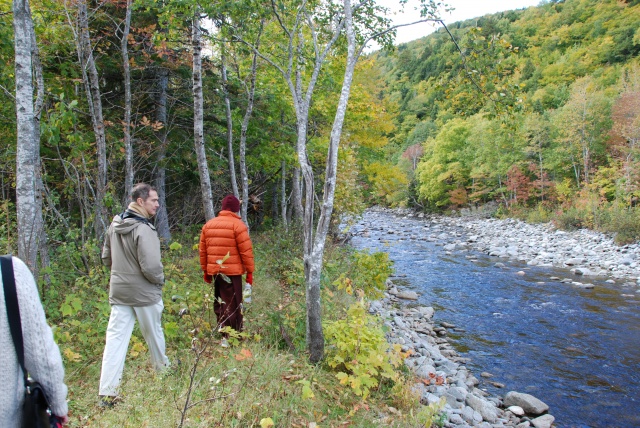Kalapa Valley is situated near the northeastern tip of Nova Scotia just above Cape Smokey near the town of Ingonish, Cape Breton. Kalapa Valley’s 113 acres are bordered by Crown land with miles of hiking trails and woodland paths to waterfalls, swimming holes, and the highlands. Bordered by steep, forested mountains on the south and the Ingonish River on the north, the valley faces due east into the Atlantic Ocean through a long protected inlet, Ingonish Harbour. The western edge of the property climbs to the Cape Breton Highlands.
Kalapa Valley is adjacent to the Cape Breton Highlands National Park and its beautiful beaches and hiking trails. The Keltic Lodge with its splendid golf course restaurant and scenic short hikes is just two miles away. Kalapa Valley is approximately one hour from Gampo Abbey.
In the summer and fall the Ingonish area is visited by thousands. Aside from the house and camping within the valley, there are many local accommodations. The town of Ingonish provides most services with a bank, grocery and liquor stores, postal outlet, hardware stores and a few restaurants.
HISTORY
In the spring of 1979, while spending ten days in Nova Scotia, the Druk Sakyong, Chögyam Trungpa Rinpoche, recognized the Ingonish River valley as Kalapa. A year and a half later, accompanied by Sakyong Mipham Rinpoche, he performed a lhasang at the entrance to the valley. Joyfully smiling in the windblown, freezing rain the Druk Sakyong pointed into the depth of the valley and said simply, “Kalapa.”
In 1993 the property became available for sale and with the blessings of Sakyong Mipham Rinpoche, a group of five community members purchased the land, which they managed and held in stewardship on behalf of the Sakyong and Shambhala. The Sakyong visited the property often, performing lhasangs and overseeing the burial of two treasure vases from Dilgo Khyentse Rinpoche.
In 1995 the Sakyong declared Kalapa Valley a Shambhala pilgrimage site and sacred park. The Sakyong selected sites for three torii gates, a shrine, and six large Ashe-inscribed protection posts. In 1998, a group of 27 participated in the installation of the protection posts around the property. Khenchen Thrangu Rinpoche conducted special blessing of these Ashe posts.
On December 16, 2000, the Sakyong, the Throne Holder, or Tridzin, of Shambhala, made the following statement:
“Kalapa Valley is unique and unusual from a geomantic point of view, and if it became part of our Shambhala Buddhist mandala, it would hold a special position. Ms. Eva Wong (master of k’an-yu or feng shui) has analyzed various places in the valley, and her report indicates amazing and auspicious land formations there. Because of its special qualities, ownership of Kalapa Valley could benefit our entire mandala. It is important that we possess it.”
The Sakyong’s remarks referred to an in-depth k’an-yu (feng shui) analysis of Kalapa Valley by master feng shui consultant, Eva Wong. Following a three-day survey of the land in September 2000, Ms. Wong summarized her report in this way:
“Kalapa Valley is the most important piece of land property in the Shambhala community. The archetypal energetic structure of Kalapa Valley is known as The Valley Spirit; it is the inexhaustible source of energy behind all other Shambhala centres and the sangha. It is the very ground that the Shambhala mandala stands on. With the proper development and use, Kalapa Valley will help energize all Shambhala centres worldwide.”
In 2003, in a most generous expression of devotion, the stewards of Kalapa Valley donated Kalapa Valley to Shambhala. The Sakyong encouraged centres throughout the world to perform long lhasangs, supplications, and aspirations on the day of the transfer of Kalapa Valley to Shambhala. Rinpoche sent these remarks in advance of this formal occasion:
“We should use the Valley as we make the Maritimes known as the centre of Shambhala International – a global community. While the capital is in Halifax, the secret heart centre is in Kalapa Valley. Its energy is essential to propagating Shambhala. We are enthusiastic. The Valley is the place of Shiwa ökar, a place to practice the Werma Sadhana….
“We should raise the Shambhala flag and the Sakyong’s flag to proclaim the lineage of the Sakyongs, and have a flag made with the Shambhala Anthem calligraphed on it. There should be a procession and formal raising of these flags with honour.”
On October 11, this was all accomplished under a vivid blue sky. On that day, the Sakyong composed an address which concluded:
“On this day of celebration of Kalapa, the sacred valley, we should recall the Rigden’s command to create enlightened society. Let us all join in celebration so that this command may be fulfilled. May we build a society based on generosity, dignity, and the understanding that all beings possess basic goodness.”

In 2005 the Sakyong started the Scorpion Seal retreat at the Kalapa Valley. the retreat was completed in sections by 2009
A Tenno retreat building was constructed deep within the valley for the Sakyong and his family’s use. Here are some poems composed on those retreats. Shiwa Okar and the Valley of White, and a profound letter to the sangha on The Lineage of the Sakyongs and Shambhala, which included these passages:
“Proclaiming the Shambhala teachings and the teachings of basic goodness is not an easy task, and it is fortunate for us that he (the Druk Sakyong) persevered. The reason that I persevere is out of my love and devotion to him, and faith in what he was doing. I feel it a privilege to trail-blaze the upper reaches of the snow mountain of Shambhala. It is an honour to practice and discover the deep profound terma that the Druk Sakyong left for us to discover.”
KALAPA VALLEY LETTER
It was many years ago on a stormy day that the Druk Sakyong, Chögyam Trungpa Rinpoche and I, with many members of the community, went to Kalapa Valley on the coast of Cape Breton. The Vidyadhara referred to it as “Kalapa,” the centre of the Kingdom of Shambhala and talked about the importance to our vision of this small, beautiful and isolated valley. By performing a lhasang that day, the valley was brought into the Shambhala world.
However for many years Shambhala did not officially own the land. A number of patrons and caretakers safeguarded the property. Over this time I was personally involved so that the property did not leave the hands of members of the Shambhala community. Now the Kalapa Valley formally and officially comes under the auspices of Shambhala. It is appropriate and auspicious that this is happening in this year when Shambhala is redefining its role to better help all sentient beings.
On a recent trip to Kalapa Valley, Eva Wong, our esteemed feng shui master, felt that this valley held the secret command of the Shambhala vision and that it would affect the energy and spirit of all of our centers. Even though many of us have not seen the land, by receiving it now, Kalapa Valley will have a positive effect on all of our activities. It will have a unique role in our community since it will not be built up into a major practice center. Rather, it will have a pavilion for the practice of the sacred Werma sadhana and sacred gardens for practitioners to visit.
On this day of celebration of Kalapa, the sacred valley, we should recall the Rigden’s command to create enlightened society. Let us all join in celebration so that this command may be fulfilled. May we build a society based on generosity, dignity, and the understanding that all beings possess basic goodness.
May Shambhala be victorious!
Sakyong Mipham Rinpoche Karme Chöling 10 October 2003
If you would like to support the maintenance of the SS Tenno Retreat or the Fengshui additions to the valley follow the links – Gratitude.
